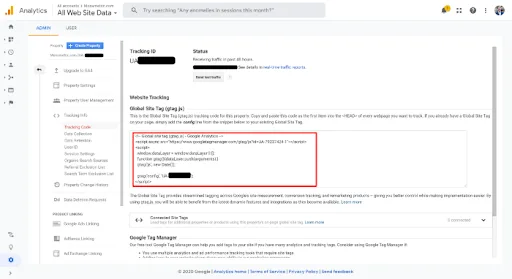Google Analytics is the industry standard for measuring your site’s traffic and user behavior. It offers a fairly user-friendly view of how many users your site has garnered, where they’re from, how they got there, and how long they stay. However, Google Analytics has a major operational flaw that most people assume Google would be smart enough to figure out. You won’t see it in your dashboard, and they won’t tell you it’s happening, but it could mean that Google Analytics is double-counting your traffic.
If you have had a sudden spike in traffic that never goes away, or your bounce rate is less than 50%, you could have Google Analytics installed twice.
Of course, you’re no fraudster and would never attempt to inflate your pageviews, so how did this happen?
This is an extremely common issue across thousands of sites each month. It typically happens like this:
You sign up for Google Analytics, follow the instructions, and manually enter your unique Google Analytics tracking code snippet in the header section of your website. Set it and forget it.
Months or years later, you discover a whole sea of plugins to track and analyze your traffic. These could be the Google Analytics plugin or another tool like Monster Insights or Jetpack Analytics.
Using plugins can be great, but they add in another instance of your Google Analytics tracking code, which means you end up with two, three, four, or more of the same tracking ID plus the original code snippet you manually installed. And as easy as that, Google Analytics is double-counting your traffic, and your dashboard is none-the-wiser.
Consequently, you’ll see double the pageviews per visit and low bounce rates.
Industry-standard bounce rates are around 70–80% (yes, the way GA calculates bounce rate is weird). You know something is wrong if your bounce rates are 0–50%.
How do I check if Google Analytics is installed more than once?
Luckily, it’s easy to troubleshoot this issue. Follow these steps to confirm Google Analytics is not double-counting your traffic.
Step 1: Open your site in Google Chrome or Apple Safari
- Chrome: Right-click on the page and select “View Page Source.”
- Safari: Go to Safari > Preferences > Advanced — check the box that says “Show develop menu in the menu bar.” Then, with your website open, click the menu item Develop > Show Page Source.
Now you’re looking at your website code.
Step 2: Search for the Google Analytics tracking ID
- On a Mac, use Command + F, and on a PC, use Control + F.
- Search for “UA-” (stands for Universal Analytics). This is the beginning of your Google Analytics tracking ID.
It’s OK if your search only yields one code section with the Google Analytics tracking code snippet. Here’s an example:
See how both tracking codes are found in the same code snippet.
You’re likely double-installed if your search yields two different places or instances of UA-code. See these example(s):
This is an example of a double installation. Notice two UA- instances are found, but they are in separate locations.
From the same site, you can see the second snippet of UA- code is being injected by a plugin called “Jetpack.”
Still not sure if you’re double-counting? Go to your Google Analytics interface, click on Settings, and go to the “tracking code” section in your property settings. Get your tracking ID and search for that ID using the already listed steps.
Fixing a Google Analytics double-tracking code Installation
If you have the Google Analytics plugin installed, but don’t use it on your WordPress Dashboard, simply uninstall it.Inversely, if you use Google Analytics WP Dashboard, you will need to manually remove the script you originally installed in the header section of your website.
Uninstalling the Google Analytics Plugin (WordPress)
Step 1: Log into the back end of your site if you’re using WordPress
Step 2: Go to Plugins > Installed Plugins
Step 3: Find the Google Analytics plugin in your list of plugins
Step 4: Click “Deactivate” > “Delete”
Step 5: Celebrate
Removing the Google Analytics Script
Step 1: Log into the back end of your site if you’re using WordPress
Step 2: Go to Appearance > Editor.
Step 3: Scroll through the long list of themes until you find “header.php” and click on it.

Step 4: Locate the first <head> tag and search for the original Google Analytics script provided in your Google Analytics dashboard.
- If you need to find your Google Analytics script go into your GA dashboard and click on Admin > Property > Tracking > Tracking Code

Step 5: Back in your header.php file, delete ONLY the GA snippet. Deleting anything else in this space could crash your site (not stressful at all). We always recommend ensuring your site is backed up in case something goes wrong. Similarly, you can copy and paste the entire header.php code into a text editor if you need to go back to what was there previously.
Step 6: Save

Verifying You’ve Solved the Problem
Load your website developer view again (F12 or right-click, then select “inspect”) and search for your “UA-” tracking code. If you still see a double instance, clear your cache/cookies and try again.
You should now only see one tracking ID for your site.
Congratulations, now you’re tracking the true amount of page views. You should see changes in your Google Analytics the next day. Your pageviews will drop, and your bounce rate will slide back into the 70–80% range. This will ensure your Pageview RPM from your ads is accurate, and you’ll have a better idea of how you can best monetize your audience.
Monumetric is committed to optimizing your experience; if you have any questions, reach us at support@monumetric.com




